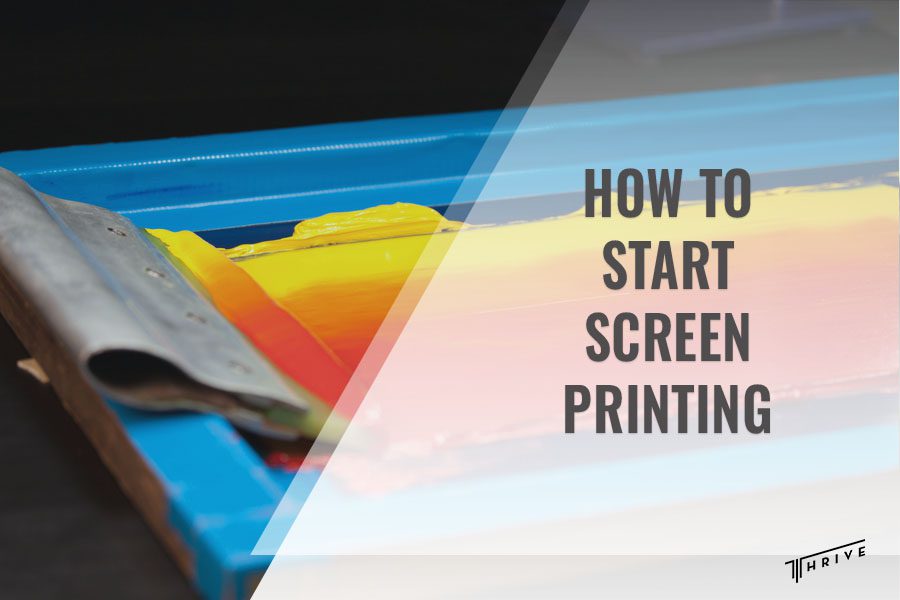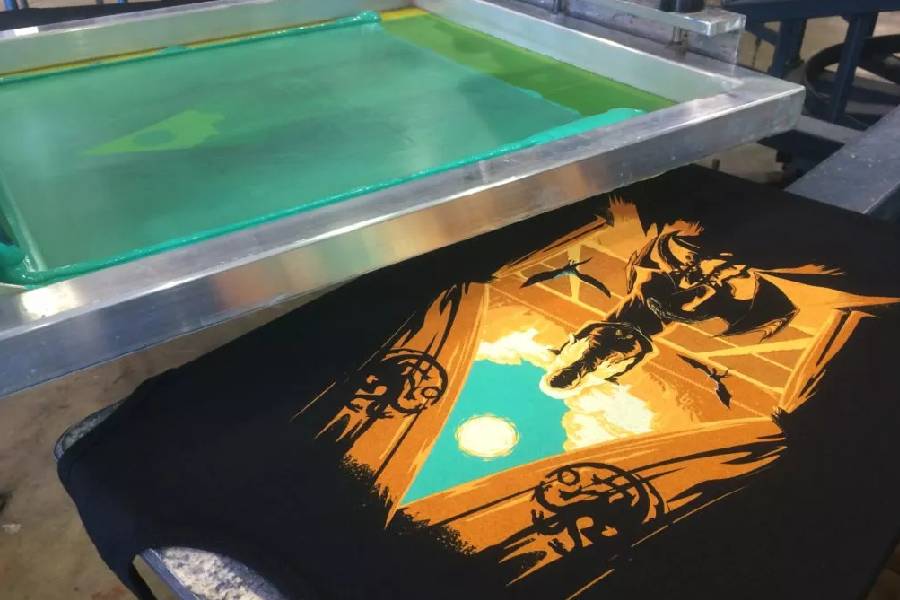
Screen printing is a versatile craft that allows you to transform your creative visions into a work of art printed on different surfaces. It is a popular printing method used in various industries to create custom clothing, artwork, and canvases. The technique creates visually appealing screen-printed products and provides high-color vibrancy. So, are you wondering how to start screen printing?
We suggest reading our comprehensive guide if you are interested in stepping into the printing world. We will explain which equipment and tools you need and how the process works. Whether you want custom apparel or unique prints, our guidance and expert tips can help you successfully start your screen printing journey.
How to Get into Screen Printing
Getting into screen printing can be an exciting venture. There is so much to learn about this creative printing process, so familiarizing yourself with the basics can be an excellent starting point. When starting screen printing, it is necessary to identify your goals and determine what screen printing aspect interests you the most.
Whether that will be custom apparel, mugs, accessories, posters, or art prints, having a clear goal will guide you through the learning process more efficiently. Before you begin, gather the essential supplies and determine a designated workspace with enough space, good ventilation, and suitable lighting.
Familiarize yourself with graphic design software to help you create and prepare your designs for screen printing. We recommend starting your printing adventure with simple designs. Then, as you gain confidence, you can move on to more intricate printing projects. Screen printing is a skill that requires practice.
Hence, don’t get discouraged by the initial challenges you may encounter, and don’t be afraid to make mistakes. Instead, learn from them. Experiment with different ink types and printing surfaces to improve your skills and refine your printing technique. Enjoy the process of improvement as you delve into screen printing.

Screen printing details you should know
You should get the necessary materials and tools to venture into screen printing. You can learn more about the technique by practicing on small projects and accessing online tutorials, courses, videos, blogs, etc.
Once you get hold of screen printing, we advise building a portfolio to document your projects and showcase your work. As you progress, consider upgrading to a commercial screen printer for increased efficiency and more professional results.
Hiring contract screen printing services can help you reach more customers. Our print experts at Thrive Screen Printing use the latest equipment to design, print, and deliver high-volume quality prints on time and on a budget.
Hence, we will use our expertise to guide you through the process of screen printing. Whether you are interested in starting a new business, such as a printing shop, or would like to learn the technique as a hobby.
What Do I Need to Get Started on Screen Printing?
To get started with screen printing, it is essential to gather the necessary supplies. So, we provided a list of materials and equipment you will need:
- Printing screen (select a screen with a suitable mesh count).
- Frame (attach the screen to a frame to create a sturdy printing surface).
- Emulsion (apply emulsion to the screen to create a stencil for your design).
- Ink ( choose a quality ink in your preferred colors).
- Transparency film (that will have your design on it).
- Squeegee (essential for spreading the ink evenly across the screen).
- A substrate (depending on what you will be printing).
Now you might wonder – “What equipment do I need to start screen printing?”
You can decide whether you would like to invest in a screen printing press or set up a DIY printing station. Remember that the press provides more stability and consistency throughout the printing process. A DIY setup, on the other hand, can be a more budget-friendly option.
Below, you will find other essential screen printing tools, materials, and conditions you need to get into printing effortlessly. Starting with the basics will give you a solid foundation for this printing technique. As you progress in printing, you might discover additional tools and equipment to benefit your needs.
Printing surface
One of the primary advantages of this printing technique is its ability to screen print on various materials. You can print graphics and designs on materials such as plastic, wood, metal, and glass. You can create various things, including T-shirts, mugs, tote bags, pillowcases, backpacks, accessories, and many more items.
Light source and ventilation
Aside from a screen printer, you will need a light source for exposing the emulsion on the screen. You can get an exposure unit, a light table, or even natural sunlight if you work with a photo emulsion. Make sure to create a dark room or a light-safe area for coating screens with emulsion and exposing them to light.
These steps are crucial for the emulsion to be properly set on the printing screen. Ensure good ventilation in your workspace, especially if you work with chemicals. It is crucial for safety during the screen printing process.
Protective gear and cleaning supplies
When doing screen printing, we recommend wearing protective gear such as gloves. This is especially vital when you are working with chemicals during the emulsion coating process. Also, have cleaning supplies at hand, such as screen cleaner, a brush, and a hose for cleaning screens after each use.
Curing equipment
Depending on the type of ink you will be using, you may need equipment for curing or setting the prints. In such a case, you can opt for a heat press, a conveyor dryer, or other curing methods. For textiles and garments, curing is necessary to make a durable print that can withstand multiple washes without fading, cracking, or rubbing off with time.
How to Start Screen Printing
Screen printing is a high-precision printing technique that involves using a mesh to transfer ink into a substrate. Let’s get into details on how this process works.
Create your design
After you gather the necessary materials, choose or create a design for your screen printing project. You can create a simple artwork or go for an intricate and visually appealing design. Keep in mind that it’s easier to begin with simpler designs.
Making a design is possible by drawing or printing the image from a computer onto a transparent acetate film. You can also use graphic design software where you can create a high-contrast black-and-white image that will be the stencil of your screen.
Prepare the screen
Once you choose a design, you need to prepare the screen. The screen is made from a piece of mesh stretched over a frame. The mesh can be made of silk, nylon, or polyester and can differ in the total amount of fibers.
A screen with a higher mesh count can print finer details and preserve a fair ink coating. On the other hand, screens with a lower mesh count let the ink flow through due to wider openings. After preparing the screen, it is time to expose the emulsion.
Exposure of the emulsion
At this step, coat the screen with photo emulsion. This is a liquid that reacts when exposed to UV light. Coat the screen in a dark room or, using a light-safe environment, dry it in a dark area. Also, ensure it is completely dry before you expose it to light. Once dry, place your design on the screen and expose it to light.

Expose the design
Place your design upside down on the flat side of the screen. Make sure to secure the substrate (T-shirt, paper, etc.) on the printing surface. Then, position the screen over it and ensure a proper alignment. Place the piece of glass on top to ensure the transparency is flat against the screen.
At this step, the screen is ready to be exposed. You can go outside and take advantage of the sunlight or use lamps. By exposing the screen to the light source, a reaction occurs, and the exposed area becomes hardened.
The light hardens the emulsion, except in the areas where your design has blocked the light. Doing so will create a stencil on the screen. After the exposure, rinse the screen with water. The areas covered with your design will wash away, revealing the design on the screen. Next, let it dry.
Setup your workspace
You can prepare your workspace for printing by securing the substrate and laying down the protective material. Position the printing screen carefully over the substrate and ensure it doesn’t move while printing.
Print your design
Once you place the printing screen, apply a thick layer of ink in the desired color. Pull the ink across the screen using a squeegee and transfer it onto the substrate by applying even pressure. Lift the screen carefully to reveal the printed design.
Dry and cure
Finally, allow the printed material to dry. You can then cure the design so that it is long-lasting. This often involves heat setting to ensure the material is durable and can go through washing cycles without fading or breaking down.
Clean your equipment
After screen printing, thoroughly cleaning your screen and tools is necessary. Doing so is crucial for maintaining the quality of your prints and extending the life of your printing equipment.
Finish screen printing
If you have carefully followed the screen printing instructions, you have successfully completed your screen printing project. Once you gain experience, you can experiment with different colors, substrates, and techniques.
By doing so, you can expand your creative abilities. When you become more comfortable with screen printing, consider expanding your operation.
Benefits of Screen Printing
If you are considering starting screen printing, it is necessary to get familiar with the advantages this printing technique provides. Screen printing is versatile, allowing you to print on different surfaces and use multiple colors.
Compared to other methods, it can create more durable designs by applying heavy ink coverage. Also, certain coatings and additives can make the ink resistant to UV light, moisture, scratches, and chemicals. While there are different types of screen printing, the printing process involves the same basic technique.
It produces vibrant and bold colors and can be cost-effective in the long run. The printing process is straightforward, as screen printing is a fast printing technique. It has diverse applications in many industries and effectively creates large batches.
Is Screen Printing a Profitable Business?
Now that you know how to start screen printing, let’s discuss the printing technique as a profitable business. Screen printing became prevalent in the 19th century and, from then on, has been widely used across various industries across the globe.
One of its most significant advantages is that it can print on almost any type of surface, whether fabric, paper, glass, wood, plastic, leather, or something else. It is scalable for your needs and can be done by hand or machine.
Given its demand and advantages, screen printing can be an excellent creative outlet and a profitable business decision. Yet, whether it will be successful depends on different factors, including the business strategy, quality of work, the market, etc.
So, is it worth starting a T-shirt printing business? To help you make an informed decision, we will discuss considerations you need to consider.
The business side of screen printing
If you plan on starting a screen printing business, we recommend you research the demand for custom-printed shirts in your target market. Consider factors like local trends, events, and a potential customer base.
Also, access the level of competition in your area. A unique selling proposition in a niche market can help you stand out. This means that high-quality and innovative designs can set your business apart. Before you dive into this venture, we recommend considering the initial investment needed for equipment and supplies.
Furthermore, a detailed business plan and well-thought marketing strategy are essential for success in this field. The same applies to building a solid relationship with customers and adapting to changing trends and customer preferences.
Additionally, compliance with legal and regulatory requirements is essential for an effective and sustainable operation. Remember, running a successful business often requires passion and commitment, which can increase your chances for success.

Conclusion
As the popularity of screen printing increases, a common question often arises, which is how to start screen printing. Embarking in screen printing involves mastering the fundamentals, investing in quality materials, and fostering creativity.
By combining these elements with patience and practice, you have the potential to bring your aesthetically pleasing designs to life. Now that we have discussed how the screen printing process works, there is only one thing to note – Enjoy the screen printing process, and let your imagination run wild!

Robert Fisher is the founder and CEO of Thrive Screen Printing and brings extensive experience in the screen printing and fulfillment industry.

